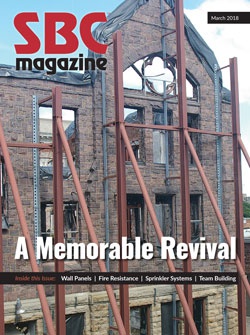A Clearer Path
A Clearer Path
Automatic sprinkler systems have been used in the United States since the 1870s. Original applications were primarily intended to protect property and were installed upon the recommendation or requirement of an insurance company. Eventually automatic sprinkler requirements were included in the building codes, initially for the protection of buildings with large areas or multiple stories that had moderate to high fuel loads.
As sprinkler systems improved and their use increased, the life-safety benefits afforded by sprinkler systems also became apparent. Today, building codes require sprinkler systems not only for property protection but also for life-safety. Metal plate-connected wood trusses are often used in buildings that require some type of fire protection system, and frequently the system of choice is sprinklers.
The effectiveness of today’s automatic sprinkler systems in protecting both property and life-safety has contributed to a gradual shift in fire suppression responsibilities from the fire service to building owners and occupants. Requiring automatic sprinkler systems in residential buildings is a cost-effective way for community leaders to protect citizens without straining municipal budgets. The result has been a proliferation of sprinklers that is likely to continue – and because of how well sprinkler systems and truss construction go together, that trend could be a good thing for component manufacturers.
Automatic sprinkler systems are, of course, used in buildings of all types of construction and with all types of structural elements. Still, the open webbing of truss construction makes it especially compatible with sprinkler systems. Sprinkler piping can usually be run through the web plane, making maximum use of the available space and eliminating costly through-drilling or loss of headroom. The openness of the truss configuration enables efficient water distribution from an activated sprinkler head, minimizing headaches for building designers and installers and lowering overall installation costs.
Building codes require automatic sprinkler protection based on the building’s occupancy group, height, potential fire area size and occupant load. As AWC has pointed out, even when automatic sprinkler systems aren’t mandated, building codes often provide incentives to install automatic sprinkler protection. For example, installation of a sprinkler system might allow building designers to increase the building area or height; provide longer egress paths; or offer a reduction in fire resistance rating requirements and restrictions on interior finish materials. These incentives typically result in more cost-effective construction by enabling the use of more efficient building components, including trusses.
Building designers are responsible for determining whether an automatic sprinkler system is required in a particular structure and, if so, responsible for determining the type of system to be used. Truss designers who understand these code requirements can recognize projects in which automatic sprinkler systems may be required and can proactively request the loading, attachment and location information necessary to design the trusses to support the additional weight of the sprinkler system. Look for further discussion of how sprinkler systems affect the truss design process in future issues of SBC Magazine.
Fire protection systems can be passive or active.
-
Passive protection systems are those in which the building elements and assemblies provide resistance to the advance of fire. Such systems would include, for example, compartmentalized construction that uses fire endurance-rated wall, floor, ceiling or roof assemblies.
-
Active protection systems are those that attempt to contain and diminish fire once it has started. Such systems would include automatic sprinklers.
Sprinkler system options
Automatic sprinkler systems must be designed and installed in accordance with Section 903.3 of the International Building Code (IBC) and one of three national standards:
- NFPA 13: Standard for the Installation of Sprinkler Systems
- NFPA 13R: Standard for the Installation of Sprinkler Systems in Low-Rise Residential Occupancies
- NFPA 13D: Standard for the Installation of Sprinkler Systems in One- and Two-Family Dwellings and Manufactured Homes
What are the differences among the sprinkler systems these three standards require?
- NFPA 13 SYSTEMS are intended to control and extinguish the fire, and can therefore be used in all types of occupancies. NFPA 13 uses a density/area concept and requires a minimum 30-minute water supply duration. To qualify for most code design incentives, such as fire endurance resistance alternatives or trade-offs, an automatic sprinkler system designed in accordance with NFPA 13 must be installed throughout the building.
- NFPA 13R SYSTEMS can be used in Group R (Residential) occupancies, up to and including four stories in height and not exceeding 60 feet in height above grade. NFPA 13R systems are intended to prevent flashover – that is, total involvement – in the room of fire origin. Preventing flashover improves the chances of occupants escaping or being evacuated. NFPA 13R uses a four-head sprinkler design with a 30-minute duration water requirement, and these systems are typically installed in prompt evacuation type dwellings or in slow evacuation type dwellings with 16 or fewer occupants. For example, these systems are used in apartment buildings, board and care facilities, hotels and dormitories.
- NFPA 13D SYSTEMS are for use in one- and two-family dwellings, mobile homes and townhomes. Like 13R systems, NFPA 13D systems are intended to prevent flashover and improve the chances of occupants escaping or being evacuated. NFPA 13D systems have the least restrictive water supply requirements: 13D uses a two-head sprinkler design with a 10-minute water duration requirement.

